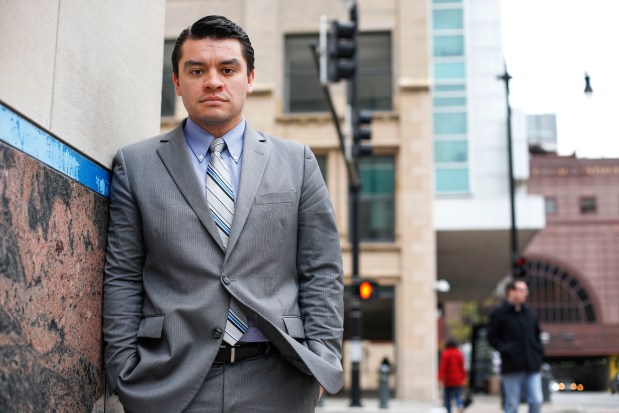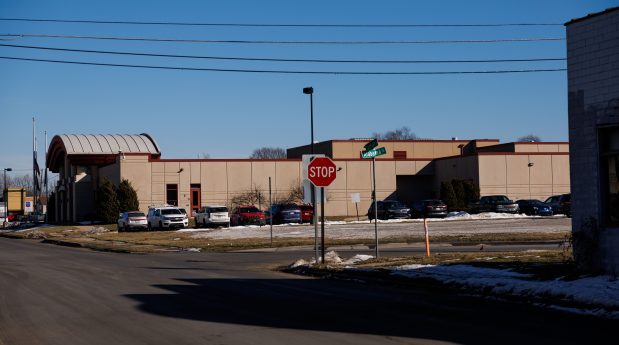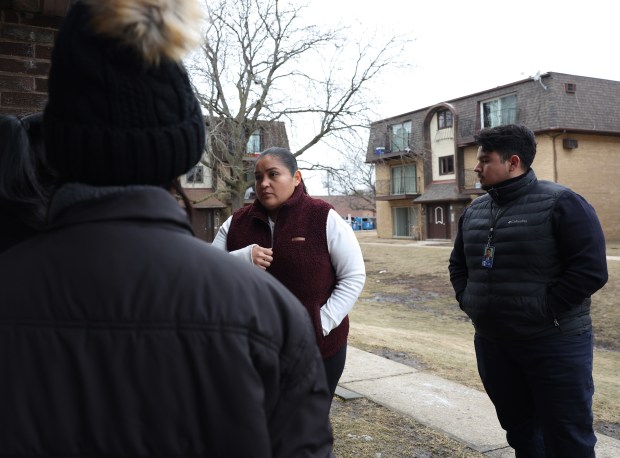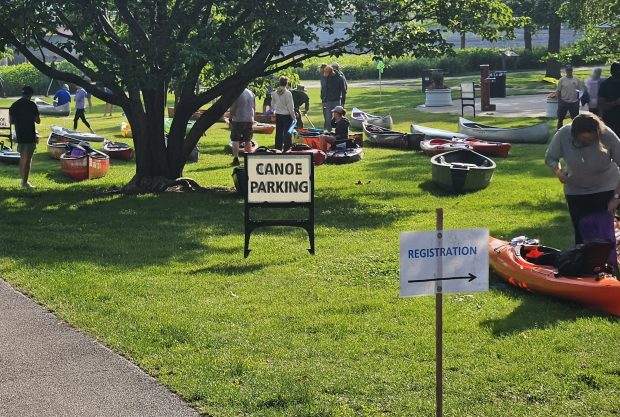Immigration agents swept the Chicago area on Jan. 26 and their presence quickly rippled across the city and suburbs, lighting up phone screens with frenzied reports of sightings.
A Hermosa couple hid in their attic when agents were spotted on the street. An agent in an ICE vest walked past homes in South Chicago. Government officials stood in a ring with with geared-up law enforcement in a photo posted to social media. TV personality Phil McGraw even joined in, contributing to the sense of spectacle, even as residents hid in their homes in fear.
The scenes played out in neighborhoods on the North, South and West sides of the city, along the Indiana border and in the suburbs after six days of anticipatory tension following the inauguration of President Donald Trump.
U.S. Immigration and Customs and Enforcement publicized more than 950 arrests nationwide that day, and Chicago Police Superintendent Larry Snelling said at least 100 people were arrested in Chicago and the surrounding area.
A month later, though, precise information about who was swept up and why remains elusive, as federal officials have declined to release detailed information about raids in Chicago. And even though national data from the first few weeks of the Trump administration have begun to trickle in, an independent group that compiles the figures said in a news release Wednesday that its analysts found inconsistencies.
In a system where people can be detained with little public information available, rosters for out-of-state jails that hold many Chicago-area detainees offer one of the only glimpses of people taken into custody amid the heightened fear and uncertainty of the past several weeks.
Though they do not represent a complete picture, the jail logs, obtained by the Tribune via public records requests, present a rare, if narrow, window into a byzantine and opaque immigration system, where people can be detained and not go before a judge for weeks, or even months. In contrast, in Illinois’ criminal justice system, arrestees must go before a judge within 48 hours and police must make arrest reports with identifying information available within 72 hours.
“A lot of the rights and expectations that people have of … courts are thwarted by the kangaroo court for immigration proceedings,” said Jacqueline Stevens, a political science professor and director of the deportation research clinic at Northwestern University.
Across the country, the number of ICE arrestees held in detention during the first several weeks of the Trump administration has increased, according to data from the Transactional Records Access Clearinghouse (TRAC), a research center based at Syracuse University that uses Freedom of Information Act requests to compile data. Experts, however, say logistical challenges may have tempered Trump’s more grandiose promises.
“What they’ve been doing is boasting about the numbers that they want to deport but then highlighting a few individual cases,” Stevens said. “And they don’t have the detention capacity to accommodate that aspiration.”
To compile a fuller picture of arrests since Trump took office, the Tribune reviewed detainee information at two Midwest county jails that double as immigration detention facilities for people arrested in Chicago and elsewhere. A public records analysis of around 200 federal detainees booked in the Clay County Justice Center in Indiana and the Boone County Jail in Kentucky from Jan. 26 to Feb. 2 revealed both the challenges of tracking people who are held in a non-transparent system as well as a partial look into the circumstances of those the Tribune could locate.
Of the nearly 200 detainee names reviewed by the Tribune, about half could not be located with confidence in national databases or local public record searches. Some appeared linked to other states in the Midwest or across the country.
Among the Chicago-area residents the Tribune found probable traces of, a range of situations emerged. They are young adults and senior citizens, living in city neighborhoods and suburban immigrant enclaves like Waukegan and Elgin. They’ve gotten traffic tickets and been leveled by bankruptcies.
Nearly 50 detainees appeared to have connections to Illinois or northwest Indiana, appearing to likely match individuals with public records ranging from civil issues and minor arrests to serious convictions. In a handful of those cases, the Tribune could not locate anything more than traffic tickets.
Some have serious criminal records — the type of people experts and attorneys say have always been priorities for immigration enforcement. Those included an Illinois man who was sentenced in 2022 to 30 months in a federal prison after he was convicted of planning to rob millions in purported drug funds from a California home and a Chicago man who pleaded guilty in 2022 to sexually assaulting a minor and was sentenced to probation.
Others appeared to have relatively minimal criminal records, such as retail theft and drug possession, based on what the Tribune could find in searching mostly local court databases.
Despite pledges from the administration that immigration authorities would target people with criminal backgrounds first, arrests of people by ICE without a criminal conviction or pending charge have risen during the early weeks of the Trump administration, according to a Tribune analysis of TRAC data. Though the bulk of ICE’s arrests are for people with records or pending charges — as has historically been the case — about 14% of those detained as of Feb. 9 had no criminal factor. At the end of January, a little over 6% of the people held after an arrest by ICE had no record or pending charges.
‘Collateral damage’
On Jan. 27, Jhony Godoy-Gregorio, a Chicago resident, was brought to Clay County Justice Center, according to public records. He was driving to work when he was pulled over by an unmarked vehicle, said his lawyer, Carla M. Casas. Godoy-Gregorio is among the 200 detainees reviewed by the Tribune.
“When he got out of the car, the officer asked his name and then just detained him,” Casas said. “There were no other questions … they just took him into custody.”
Godoy-Gregorio has since been transferred to Jackson Parish Correctional Center in Jonesboro, Louisiana — about a 14-hour drive from Chicago. He had no previous arrests or convictions, his lawyer said, and the Tribune could not locate a criminal history for him.
His path from arrest to a Louisiana jail cell is representative of a disorienting journey for detainees, who according to attorneys and advocates sometimes don’t even know which state they are in as they are shuttled among facilities while authorities seek out available bed space. And Godoy-Gregorio, his attorney said, is not even the type of person the Trump administration has said it is targeting.
Casas said he is not a citizen of the United States but has never been in removal proceedings — the legal process to determine if a non-citizen should be removed from the U.S. People with prior removal proceedings are more likely to be targeted by ICE for arrests, she said.
“(Godoy-Gregorio) had zero contact with any law enforcement. So he definitely doesn’t fit the criteria of who they are supposed to be detaining,” Casas said.
As Biden-era safeguards are dropped, those who work with immigrant populations fear that law-abiding people will get swept up by immigration authorities. Agents have been empowered to make collateral arrests, meaning they can take people into custody for immigration violations they come across while serving other warrants and enter spaces previously designated as safe, such as churches and schools.

Dario Castaneda, an immigration attorney who practices in Illinois and Florida, said he has heard from people who were taken into custody because ICE came for a relative. One client of his was arrested after involvement in a traffic accident the client did not cause.
“What happens is there is a lot of collateral damage, unfortunately,” he said.
Varying criminal histories
In other cases, according to the Tribune’s review of detainees, people arrested do appear to match individuals with serious criminal histories.
In December 1995, Marek Josko, 71, crashed his car while driving with a .19 blood-alcohol level in Lake Forest, according to news reports and court records. The driver of another car, Dennis Bourassa, was killed.
But before Josko could be tried for reckless homicide, he fled to Poland, where he lived as a fugitive for 25 years, according to a Lake County News-Sun report. He was extradited back to the U.S. and stood trial before a jury in 2021 as prosecutors sought to reconstruct the evidence as best they could after more than two decades.
Josko was convicted, served time in prison and was paroled last year. He now appears to be heading back out of the country.
Josko is among those booked on an immigration hold in Clay County for whom the Tribune was able to find a probable local link. He was detained Jan. 29, according to Clay County records.
Serious felony convictions like Josko’s have always been a greater priority for deportations, but the Tribune’s review also located people who appeared to have only minimal contact with the criminal justice system.
Among the likely matches are a man, around 47, who was convicted in 2011 of illegal entry into the U.S. and sentenced to serve 25 days in detention, according to federal court records. A criminal complaint said Border Patrol agents encountered him in Arizona and found that he entered the country without legal permission. In 2014 he was pulled over in DuPage County for not having a valid license, according to court records.
Diana Rashid, an attorney working for the National Immigrant Justice Center’s Detention Project, said that anecdotally, she has seen more people swept up for minor infractions recently.
“What remains to be seen is will this increase continue, or will it come in waves?” Rashid said. “Under the first Trump administration, it was definitely waves. It was flashy press conferences that they would put out, and we would see an increase in people calling our hotline.”
A ‘cash cow’ for local jails
The Clay County Justice Center sits on a quiet street across from the county courthouse. Shackled inmates in striped jumpsuits periodically shuffle to court appearances escorted by deputies.
But most of the inmates housed in the large complex armored by concrete walls are not locked up by the county and likely had never previously stepped foot in the small town about 60 miles southwest of Indianapolis. Rather, they are held there by federal authorities for alleged immigration violations.

Chicago-area immigration detainees are commonly taken to be held in Clay County, as well as Boone County in Kentucky and Dodge County in Wisconsin because Illinois law prohibits local jails and prisons from being contracted for such use. But as bed space dwindles, inmates, like in Godoy-Gregorio’s case, can be taken elsewhere. The administration has even been moving detainees awaiting deportation offshore, holding them in Panama and at Guantanamo Bay, according to news reports.
“They’re over capacity already,” said immigration lawyer Mario Godoy.
In 2024, Clay County added a new wing and expanded bed capacity, even as ICE fights a federal lawsuit over conditions in the detention center. The suit, filed in 2022 by detainees against ICE, the U.S Department of Homeland Security and other government officials, accused Clay County officials of treating federal inmates as a “cash cow,” using funds meant to care for inmates for county expenses and discretionary spending.
Additionally, the suit said, ICE turned a blind eye to the diverting of funds and substandard conditions, including dirty living quarters and a failure to give inmates enough food.
The jail failed a performance evaluation in 2021, according to the suit.
In a statement, an attorney representing Clay County said officials “vigorously denied the allegations in the 2022 complaint and the Court has dismissed all of the claims against Clay County in the litigation.”
A judge in December dismissed the final count against Clay County in the suit but indicated that the count could potentially be pursued in state court.
Miguel Ávila, 50, spent more than nine months in the Clay County Justice Center before he was released last summer. He described difficult conditions, often going without any access to sunlight or fresh air.
“From the minute you enter, you suffer degradation, humiliation, racism,” Ávila said. “It’s psychological torture.”
Ávila, who lives in Indiana, has been in the U.S. for over 20 years and is facing a pending drunk-driving charge. Unrelated to that charge, he is applying for a visa that allows victims of certain crimes to remain in the U.S. He also volunteers with Indiana Assistance to Immigrants in Detention, a group that visits the jail once a month to meet with current detainees.
“They are extremely scared,” he said. “Despite the fact that they are facing deportation, they are deeply concerned about their families outside jail who they can’t provide for. There is a lot of disinformation and fear under Trump.”

On a day in late January, nearly 75% of the people in the Clay County Justice Center were held for the federal government, according to an analysis of Clay County jail records.
According to an agreement between Clay County and the Department of Justice provided to the Tribune after a public records request, the jail maintains approximately 70 beds for federal prisoners at a rate of $85 per person per day.
In just a three-day period, though, the county booked nearly 80 people on immigration holds from Jan. 26 to Jan. 28, according to an analysis of a Jan. 28 jail log.
An agreement between Boone County and the federal government provides that the county must reserve about 250 beds at $88 per person per day.
People are sometimes held in detention at Clay County for long periods of time, depending on the circumstances of their cases, said Robin Valenzuela, 38, a volunteer with Indiana AID, the group that allows volunteers monthly access to the jail to provide legal referrals, resources and emotional support to detainees. Those in jail often face difficulties communicating with relatives outside, she said.
“(In February), a lot of them seemed shocked. There was a person who didn’t even know where they were. They didn’t know what state they were in, ” she said. “We had a lot of people who … didn’t know why they were being punished or what they had done wrong.”
Hoping for bail
Godoy-Gregorio has been detained for 27 days.
His lawyer is hopeful that because he has no criminal history, an immigration judge will allow him to be released on bail. He has several children and a wife. He was in the process of pursuing legal avenues to stay in the U.S. when he was detained, according to Casas. His family has had trouble contacting him in detention in Louisiana.
He was able to connect with Casas, she believes, because her name is on a list of attorney referrals that was passed around in the Clay County Justice Center. She filed a motion seeking his release on bond. His hearing is scheduled for Feb. 25, after being delayed with no explanation.
Through his wife and his attorney, Godoy-Gregorio has compiled letters of support from his church and community for the judge. He is employed, Casas said.
“I’m hoping that this is not going to be a high bond situation because he’s not a flight risk. He’s got family, he’s got a home he’s going back to when he’s released,” she said.
If he is awarded bond, someone who has legal status — either a green card or a U.S. citizen — must make the payment in full, according to Casas.
The bond process is complicated and difficult to navigate. That means that even if Godoy-Gregorio is allowed release, it may take him a few days to work out the logistics.
But he hopes to be reunited with his family soon.





